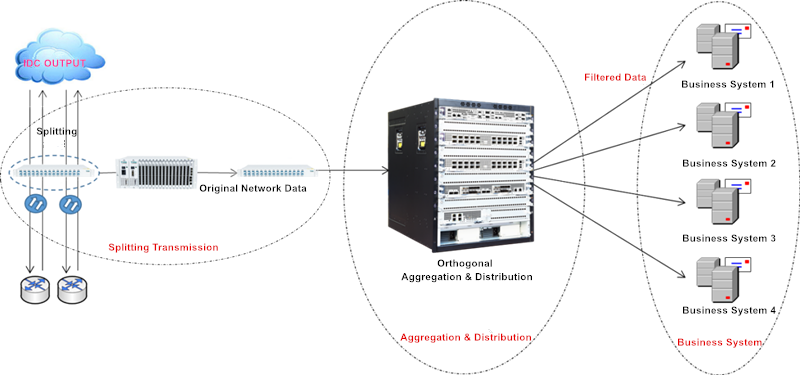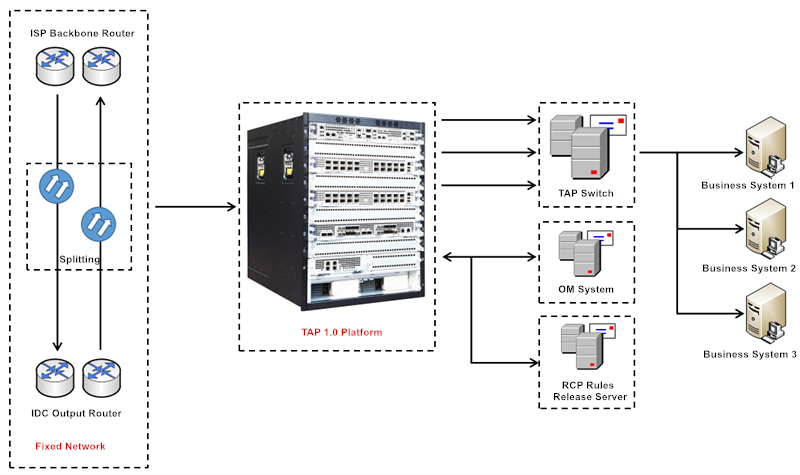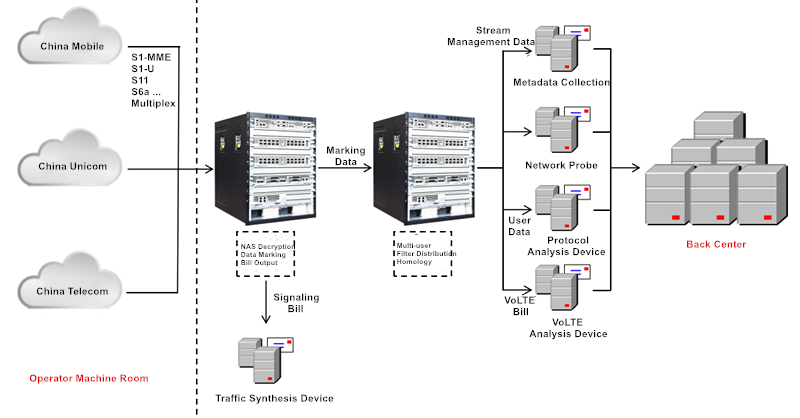
TAP System
Product Overview
Vispace 1000 series TAP equipment is the main network visualization product of Visint®. The device processes and outputs the access signals to provide a complete solution for multiple scenarios such as mobile networks, IDCs, and metropolitan area networks. Build a custom platform that integrates access, processing, and forwarding of complex application requirements such as ultra-high-flow filtering, distributioning and forwarding, ultra-high density mobile network signaling analysis, and ultra-high-performance DPI processing.
Inquiry Now
Vispace 1000 series TAP equipment is the main network visualization product of Visint®. The device processes and outputs the access signals to provide a complete solution for multiple scenarios such as mobile networks, IDCs, and metropolitan area networks. Build a custom platform that integrates access, processing, and forwarding of complex application requirements such as ultra-high-flow filtering, distributioning and forwarding, ultra-high density mobile network signaling analysis, and ultra-high-performance DPI processing.
Visint® TAP has improved the product on the basis of the commonly used ATCA architecture equipment in the past, introducing the OCP (Open Compute Project) design concept, adopting a new backless design, equipped with the latest network processor and ultra-high capacity Switch chip. Compared with the traditional ATCA architecture, the interface density, computing power and switching capacity have all doubled, and a single business processing board can reach a maximum processing capacity of 800Gbps.
Visint® TAP currently supports full access, processing, and forwarding of data on various ports (interface types of ultra-long-distance or long-distance) such as 10G POS/WAN, 10GE, 25GE, 40GE, and 100GE. It consists of packet processing blade, computing processing blade, exchange management blade, main control board, fan board, chassis, etc. Visint® TAP has three models, which support the maximum access of 6T, 16T and 32T traffic.
It can support up to 16 service slots, 2 main control slots, 2 switching slots and 6 fan slots.
Size: 445 * 260 * 550mm, Height: 6U, Net weight: 20kg;
Size: 445 * 540 * 850mm, Height: 12U, Net weight: 70kg;
Size: 445 * 930 * 850mm, Height: 21U, Net weight: 96kg.
The access bandwidth can be up to 32T.
Supports full access, processing and forwarding of 10G, 40G and 100G signals.
The processing capacity of a single board can be up to 800Gbps, and the processing capacity of the whole machine can be up to 12.8Tbps.
Support DC/AC power supply, 6U equipment AC/DC power supply supports 1 + 1 redundancy, 12U equipment AC/DC power supply supports 3 + 1 redundancy, and 21U equipment AC/DC power supply supports 7 + 1 redundancy.
System Parameter | Technical Index | ||
Regular capacity | IMSI, MSISDN, IMEI, TAC, ECI, APN rule total capacity | 13w (shared) | |
IPv4 precise quintuple rule capacity | 800W, 1500W | ||
IPv6 precise quintuple rule capacity | 200W, 800W, 500W | ||
Feature code dynamic binding quintuple IPv4 rule capacity | 500W | ||
Feature code dynamic binding quintuple IPv6 rule capacity | 100W | ||
IPv4 mask quintuple rule capacity | 52W (shared) | ||
IPv6 mask quintuple rule capacity | 26W (shared) | ||
Fixed position signature rule capacity | 13W (shared) | ||
IPv4 compound rule capacity | 10W (shared) | ||
IPv6 compound rule capacity | 6.5W, 6W (shared) | ||
TCP Flag rule capacity | 104W (shared) | ||
MAC rule capacity | 104W (shared) | ||
Number of simultaneous online user sessions supported by a single operator | 10000W | ||
Flow table capacity | IPv4 flow table capacity | 5000W, 26000W | |
IPv6 flow table capacity | 5000W, 4000W | ||
Processing performance | The maximum processing capacity is 800Gbps single board, which can support the processing capacity of 1.2T, 2.4T, 4.8T, 6.4T, 12.8T. | ||
Multi-user | With data-oriented management and control functions for multiple business users, up to 4 users are supported; each is independent, does not interfere with each other, and has independent business data, rule import and operation permissions. | ||
Multi-operator | Supports simultaneous access and processing of multiple operator data, each operator's data access, processing and offload output are independent, and each operator supports multi-user configuration | ||
Port mirroring | Input port mirroring | The single-board card supports up to 4 input ports mirroring, the mode is 1 to 1. | |
Output port mirroring | The number of mirror ports is unlimited, and the mode supports 1 to1 and one-to-many. | ||
Rule matching | Rule type | Support IPv4/Ipv6-based precise quintuple, LTE rules, flexible quintuple rules, masked quintuples, fixed position signatures, composite rules, all-inclusive floating position signature rules and many other types of rule matching functions. Each element in the rule exactly matches the corresponding element in the IP packet. | |
Data processing | Forward action | Support 4 types of forwarding actions, including forwarding, discarding, flow sampling, and flow locking. | |
Message identification | Supports identification of common fixed-line and mobile Internet types of common messages, and supports unidentified messages that can be output from a specified distribution group; by analyzing L2-L4 related information to identify various types of data messages and identify message protocol types , and distinguish the types of message protocols and perform different operations. For packets of unrecognized type, it is discarded or forwarded to the designated port. | ||
Unrecognized message output | It supports the default way to process unidentified packets. When the distribution group contains multiple ports, the distribution group is output using the Round_Robin algorithm. | ||
Carrying message information | Support MAC field information carrying, including front-end collection device marking rule ID, message quintuple HASH value, front-end collection device output port number; marking the MAC header of the message machine number, user ID, device input port direction, source MAC address and other information. | ||
Tunnel message processing | Support matching and HASH output based on the inner quintuple or outer quintuple of the tunnel message. Supports identification of mainstream tunnel messages; supports overall configuration. | ||
Message stripping | Support MPLS, VLAN, IP channel (including GTP, GRE) and other packet header stripping output, of which VLAN and MPLS support up to 10 layers. | ||
Packet header output | Support the output of the packet header from a specific port group on the common port, and set whether to enable the packet header output function. | ||
Message truncation function | Support message truncation function, the output format is the network layer and transmission layer header of the original message. | ||
Packet sampling | Supports sampling of packets other than unidentified packets. | ||
Signaling reduction | Support S1-MME, S11, S6a, Gn interface signaling restoration; supported bill types include: attach, detach, location update, periodic update, X2 handover, S1 handover, service request, create session, delete session, authenticate Rights, authentication, security mode, SMS status report, online and offline, etc. | ||
Signaling decryption | Support NAS signaling decryption in S1-MME and statistical query of decryption success rate. | ||
Associated marking | According to the analysis result of the signaling message, the user data is correlated, and the user message is correlated learned and marked according to the label format. | ||
Port pre-filtering | Support to configure Gn port and Rp port pre-filtering; Gn port filtering can realize only GTP and SCTP protocol traffic; Rp port filtering supports filtering of signaling data of a10 and a11 interfaces. | ||
Network element statistics | Support the query of statistical information such as the traffic of each logical interface such as S1-MME, S11, Gn, and the data marking rate of each logical port. | ||
Flow management | Flow management | Support the sampling and output of the first N packets for each flow in the packet; support the independent configuration of TCP flow management and UDP flow management, the first N packets in each direction are output from a specific port group; support global configuration, The first N packets of the input traffic are output, and the N + 1th packet is discarded, and the range of the N value is 1 ~ 10. | |
Flow statistics | Support global setting to enable flow statistics function, count input data flow, and output statistical information, the statistical information format is NetFlow, output ratio is 1: 1 ~ 1: 1000. | ||
Stream association | Supports parsing and correlation of OPC_DA, FTP passive mode, RTSP, SIP and other protocols to realize the output of multimedia and other data traffic from the designated port. | ||
Load balancing | Support static load balancing algorithm, load sharing among each member of the port group according to the hash result of input traffic; support load balancing based on source IP, destination IP, source port, destination port, protocol type. | ||
Hash method | Support a total of 9 types of Hash based on source IP Hash, destination IP Hash, roaming Hash and other types of aggregation and distribution methods, can achieve the same source and sink, load balancing. | ||
Server dynamic scheduling rules | Support rule server remote dynamic scheduling rules, support the addition and deletion of rules. And can support the rapid download of batch rules and rule synchronization. | ||
Network management function | Through the network management system to achieve configuration management, log management, operation and maintenance, etc., supports real-time monitoring of the operating status of the device, and supports the fault alarm function. It can be accessed through serial ports (SNMPv1, v2c, V3, CLI) and remote (telnet, SNMP, SSH) and other methods. | ||
IDC TAP system is an integrated data collection and processing platform based on the IDC business scenario. It is usually deployed in the IDC egress area, and is connected to the original network's original traffic through bypass deployment. It integrates functions such as traffic filtering, homologous homology, and load balancing to provide efficient and safe data for back-end business systems. Based on the orthogonal platform architecture, aiming at large-scale high-density application scenarios. The architecture performance is superior to the mainstream solutions in the market, providing more competitive solutions for IDC. At present, this solution has been widely deployed and operated stably in the IDC scenario.

Figure 1. IDC Application Scenario
Application 2: MAN Solution
The integrated data TAP platform based on the metropolitan area network business scenario is mainly connected to the metropolitan area network through parallel connection (bypass deployment). The operation and maintenance system and the RCP rule delivery server manage and maintain the orthogonal 1.0 platform Supports 31 types of quintuple types, masked quintuple, all-inclusive floating and other types of matching, stream association, stream locking, stream management and other functions to meet complex application requirements. Based on the orthogonal platform architecture, the architecture performance is superior to the mainstream solutions in the market, and supports the flexible formulation of large-capacity solutions. Effectively reduce the data flow to the back-end business system, reduce the amount of back-end business system deployment, and improve the overall program advantages. At present, the solution has been widely deployed and operated stably in the metropolitan area network scenario.

Figure 2. MAN Application Scenario
Application 3: Mobile Network Solution
The 4G unified TAP system is an integrated data collection and processing platform based on mobile network business scenarios. It integrates signaling analysis and restoration, NAS decryption, user data association marking, and filtering and distribution functions. Complex application requirements such as traffic filtering and forwarding, ultra-high-density mobile network signaling analysis, and ultra-high performance user association marking. Based on the orthogonal platform architecture, the NPS+X86 solution is used to achieve the integrated collection and processing of mobile network scenarios. For large-scale high-density application scenarios, the architecture performance is superior to the mainstream market solutions, and it supports the flexible formulation of large-capacity solutions. Widely deployed applications in the network environment.

Figure 3. Mobile Network Application Scenario